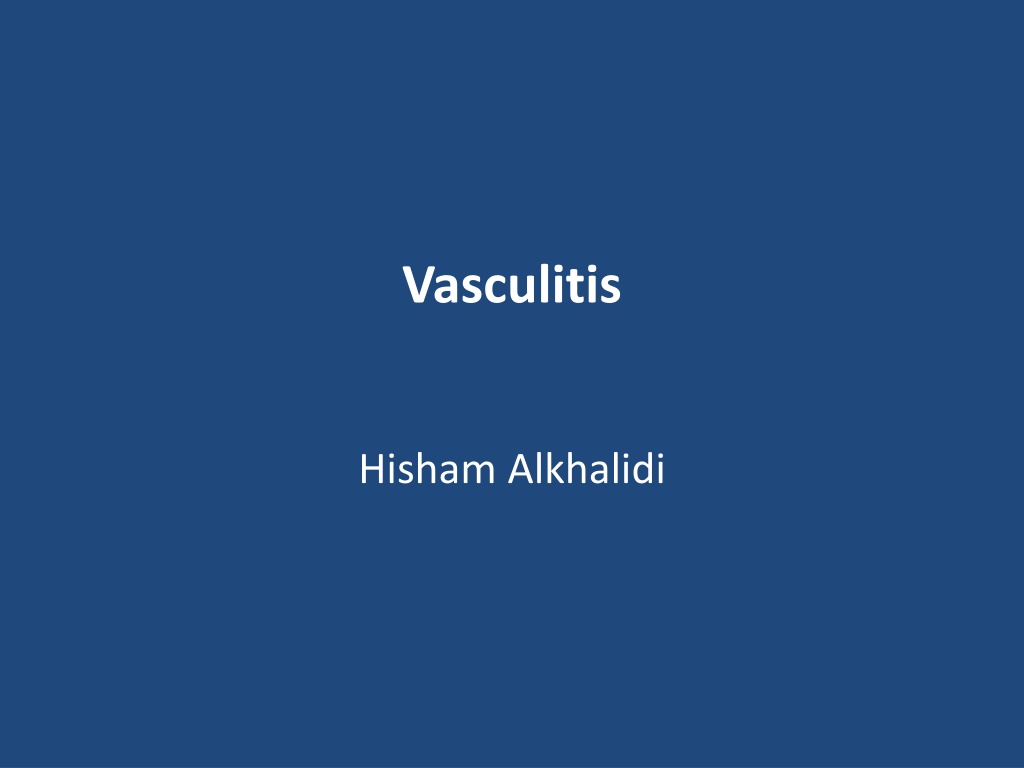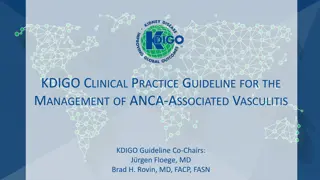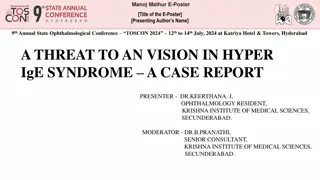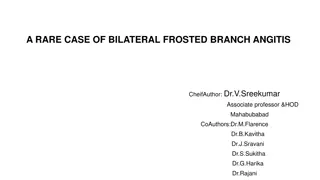Vasculitis
Vasculitis is a vascular inflammatory condition with various causes, including immune complex deposition and physical/chemical injury. Different types of vasculitides exist, each affecting specific vessels and organs. Giant-Cell (Temporal) Arteritis is a common form involving chronic inflammation of arteries, particularly in the head. Clinical features include vague symptoms and intense pain along the temporal artery. Diagnosis requires biopsy and histological confirmation, with treatment typically involving corticosteroids.
Download Presentation

Please find below an Image/Link to download the presentation.
The content on the website is provided AS IS for your information and personal use only. It may not be sold, licensed, or shared on other websites without obtaining consent from the author.If you encounter any issues during the download, it is possible that the publisher has removed the file from their server.
You are allowed to download the files provided on this website for personal or commercial use, subject to the condition that they are used lawfully. All files are the property of their respective owners.
The content on the website is provided AS IS for your information and personal use only. It may not be sold, licensed, or shared on other websites without obtaining consent from the author.
E N D
Presentation Transcript
Vasculitis Hisham Alkhalidi
Vasculitis Vascular inflammatory injury, often with necrosis
Vasculitis Causes immune-mediated : Immune complex deposition Antineutrophil cytoplasmic antibodies (ANCAs) Anti-endothelial cell antibodies Autoreactive T cells invasion of vascular walls by infectious pathogens Physical and chemical injury
Summary of Vasculitides Vessel Disease Notes Giant-cell arteritis >50. Arteries of head. Large Takayasu arteritis F <40. Pulseless disease Polyarteritis nodosa Young adults. Widespread. Medium Kawasaki disease <4. Coronary disease. Lymph nodes. Wegener granulomatosis Lung, kidney. c-ANCA. Small Churg-Strauss syndrome Lung. Eosinophils. Asthma. p-ANCA. Microscopic polyangiitis Lung, kidney. p-ANCA.
Giant-Cell (Temporal) Arteritis The most common Chronic, typically granulomatous inflammation of large to small-sized arteries Principally affects the arteries in the head- especially the temporal arteries Rarely the aorta (giant-cell aortitis)
Giant-Cell (Temporal) Arteritis Unknown cause Likely immune origin, T cell-mediated
Giant-Cell (Temporal) Arteritis Clinical features > 50 years of age Vague symptoms: Fever, fatigue and weight loss May involve facial pain or headache Most intense along the course of the superficial temporal artery, which is painful to palpation
Giant-Cell (Temporal) Arteritis - Definite diagnosis depends on: biopsy of an adequate segment and histological confirmation - Treatment: corticosteroids
Polyarteritis Nodosa Systemic Small or medium-sized muscular arteries But not arterioles, capillaries, or venules Typically involving renal and visceral vessels but sparing the pulmonary circulation
Polyarteritis Nodosa all stages of activity (from early to late) may coexist in different vessels or even within the same vessel
Polyarteritis Nodosa Clinical picture Largely young adults Typically episodic, with long symptom-free intervals Because the vascular involvement is widely scattered, the clinical findings may be varied and puzzling
Polyarteritis Nodosa Clinical picture Fever and weight loss Examples on systemic involvement: Renal (arterial) involvement is common and a major cause of death Hypertension, usually developing rapidly Abdominal pain and melena (bloody stool) Diffuse muscular aches and pains Peripheral neuritis Biopsy is often necessary to confirm the diagnosis
Polyarteritis Nodosa No association with ANCA Some 30% of patients with PAN have hepatitis B antigenemia If untreated, the disease is fatal in most cases Therapy with corticosteroids and other immunosuppressive therapy results in remissions or cures in 90%
Polyarteritis Nodosa Complications Vessel rupture Impaired perfusion: Ulcerations Infarcts Ischemic atrophy (not infarction) Haemorrhages in the distribution of affected vessels may be the first sign of disease
Antineutrophil Cytoplasmic Antibodies Cytoplasmic localization (c-ANCA) -> the most common target antigen is proteinase-3 (PR3) typical of Wegener granulomatosis Perinuclear localization (p-ANCA) -> most of the autoantibodies are specific for myeloperoxidase (MPO) microscopic polyangiitis and Churg-Strauss syndrome ANCAs serve as useful diagnostic markers for the ANCA-associated vasculitides Their levels can reflect the degree of inflammatory activity
Microscopic Polyangiitis Necrotizing vasculitis that generally affects capillaries as well as arterioles and venules of a size smaller than those involved in PAN Rarely, larger arteries may be involved All lesions of microscopic polyangiitis tend to be of the same age in any given patient Necrotizing glomerulonephritis (90% of patients) and pulmonary capillaritis are particularly common
Microscopic Polyangiitis Pathogenesis In many cases, an antibody response to antigens such as drugs (e.g., penicillin), microorganisms (e.g., streptococci), heterologous proteins, or tumor proteins is the presumed cause This can result in immune complex deposition, or it may trigger secondary immune responses p-ANCAs are present in more than 70% of patients
Microscopic Polyangiitis Depending on the organ involved, major clinical features include: Hemoptysis Hematuria and proteinuria Bowel pain or bleeding Muscle pain or weakness Palpable cutaneous purpura
Wegener Granulomatosis Triad: Acute necrotizing granulomas of the upper and lower respiratory tract (lung), or both Necrotizing or granulomatous vasculitis affecting small to medium-sized vessels (most prominent in the lungs and upper airways) Focal necrotizing, often crescentic, glomerulitis
Wegener Granulomatosis 40-50 years Without Rx -> 80% die With Rx -> 90% live (not cured) The Rx -> immunosuppression
Churg-Strauss syndrome Additional reading Eosinophil-rich and granulomatous inflammation involving the respiratory tract and necrotizing vasculitis affecting small vessels Associated with asthma and blood eosinophilia Associated with p-ANCAs.
Thromboangiitis Obliterans (Buerger Disease) Unknown eitology Results in severe vascular insufficiency and gangrene of the extremities Focal sharply segmental acute and chronic inflammation of medium-sized and small arteries, especially the tibial and radial arteries, associated with thrombosis Almost exclusively in heavy tobacco smokers and usually develops before age 35
Thromboangiitis Obliterans (Buerger Disease) In early stages, mixed inflammatory infiltrates are accompanied by luminal thrombosis; small microabscesses, occasionally rimmed by granulomatous inflammation The inflammation often extends into contiguous veins and nerves (a feature that is rare in other forms of vasculitis)
Thromboangiitis Obliterans (Buerger Disease) Clinical features cold-induced Raynaud phenomenon instep foot pain induced by exercise (instep claudication) a superficial nodular phlebitis (venous inflammation) Chronic extremity ulcerations can develop, progressing over time to frank gangrene Smoking abstinence in the early stages of the disease often can ameliorate further attacks; however, once established, the vascular lesions do not respond to smoking abstinence.
Homework HENOCH SCHONLEIN PURPURA








